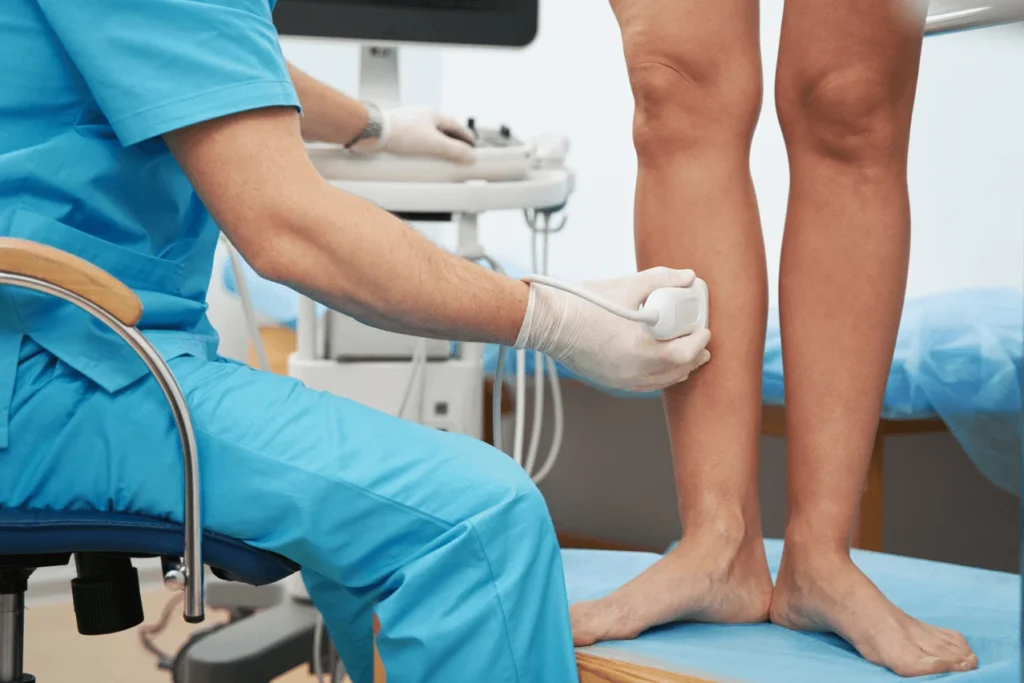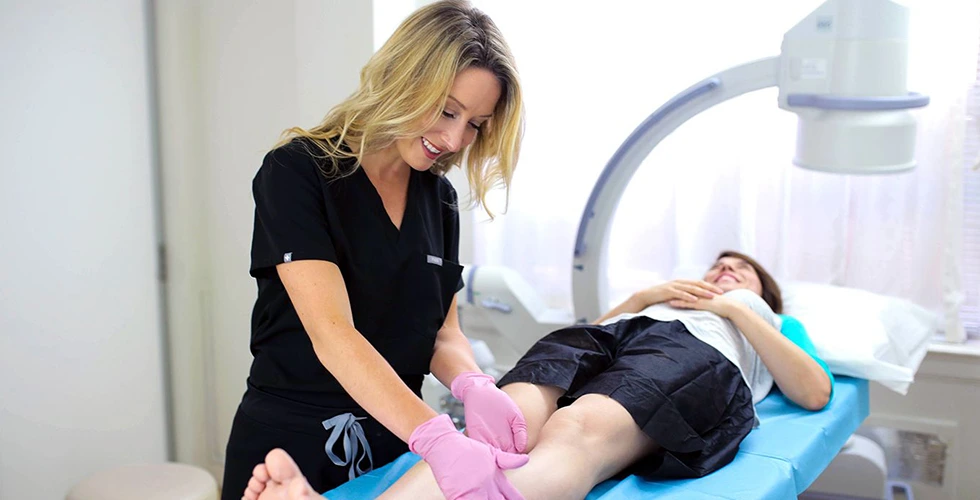Are you tired of dealing with unsightly spider veins or painful varicose veins? If so, you’re not alone. Vein issues are more common than you might think, affecting people of all ages and backgrounds. At Maryland Vein Clinic, we understand the physical and emotional discomfort that vein problems can cause, and we’re here to help. Our team of board-certified vein doctors specializes in minimally invasive vein treatments, providing comprehensive care for patients in the Bethesda, Maryland area, just outside of Washington, DC.
What Are Common Vein Issues?
Spider Veins
Spider veins, medically known as telangiectasias, are small, dilated blood vessels that appear just beneath the surface of the skin. They often resemble fine, branching webs or red and blue lines. While they are typically harmless, spider veins can be a cosmetic concern for many people. They commonly occur on the legs and face and are more prevalent in women. Factors such as genetics, hormonal changes, pregnancy, and prolonged periods of standing or sitting can contribute to their development.
Varicose Veins
Varicose veins are enlarged, swollen veins that often appear twisted, bulging, and raised above the skin’s surface. They can be blue, purple, or greenish in color and are typically found on the legs, although they can occur elsewhere. Varicose veins can cause discomfort, including aching, throbbing, and a heavy sensation in the legs. They develop when the valves within the veins weaken, allowing blood to flow backward and pool within the vein. Varicose veins are usually caused by serious conditions like chronic venous insufficiency.
Chronic Venous Insufficiency
Chronic Venous Insufficiency (CVI) is a medical condition that results from the dysfunction of the venous system, particularly the lower extremities, causing impaired blood flow from the legs back to the heart. This condition arises when the one-way valves in the leg veins, which normally facilitate the upward flow of blood against gravity, become damaged or weakened. As a consequence, blood may pool in the leg veins, leading to increased pressure within the vessels and a range of symptoms.

Why the Risk of Vein Problems Increases With Age
The risk of developing vein problems, such as spider veins and varicose veins, tends to increase with age due to several factors. One significant factor is the natural aging process of the veins themselves. As we age, the walls of our blood vessels, including veins, can gradually lose their elasticity and become less resilient. This loss of elasticity can make it more challenging for the veins to efficiently return blood from the extremities back to the heart.
Additionally, the valves within the veins, responsible for preventing the backward flow of blood, may weaken over time, contributing to venous insufficiency. Another contributing factor is the cumulative effect of lifestyle factors and environmental influences. Prolonged periods of sitting or standing, which are common in older adults due to work or reduced physical activity, can increase the pressure on the leg veins, potentially leading to varicose veins.
Vein Problems Can Affect Individuals of All Ages
While it’s true that the risk of vein problems tends to increase with age, it’s essential to recognize that vein issues can affect individuals of all ages. Young adults and even teenagers can experience spider veins, often as a result of genetic predisposition or hormonal changes during puberty. On the other hand, varicose veins, more commonly associated with middle-aged and older adults, can occasionally develop in younger individuals due to factors like prolonged standing or a family history of vein problems.
Reasons Why Younger Patients May Get Vein Problems:
- Genetics: Family history can influence vein health. If you have close relatives with vein problems, you may inherit a genetic predisposition to develop them at a younger age. Genetic factors can make the veins’ walls and valves less resilient, making them more susceptible to chronic venous insufficiency and other vein problems over time.
- Hormonal Changes: Hormonal fluctuations can impact vein health, especially in young adults. During puberty, pregnancy, or while using hormonal contraceptives, changes in hormone levels can weaken vein walls and valves, making it more likely to develop spider veins. Women are particularly susceptible to hormonal-related vein issues.
- Prolonged Sitting or Standing: Occupations or lifestyles that require extended periods of sitting or standing can strain the leg veins. Younger individuals working in jobs that involve long hours of sitting at a desk or standing on their feet may experience increased pressure on the leg veins, potentially leading to vein problems.
- Obesity: Excess body weight is a well-known risk factor for vein problems. Younger individuals who are overweight or obese face an elevated risk, especially if other risk factors, such as genetics, are present. Excess weight places additional pressure on the veins, making it more difficult for them to efficiently return blood to the heart. Maintaining a healthy weight through diet and exercise can reduce the risk of developing vein issues.
- Injuries or Trauma: Accidents or injuries that damage veins can happen at any age. Trauma to the veins can disrupt their normal function and lead to vein-related issues, such as blood clot formation or venous insufficiency. Prompt medical attention is crucial in such cases.
- Medical Conditions: Certain medical conditions, such as deep vein thrombosis (DVT) or vascular malformations, can affect individuals at a younger age. These conditions can directly impact vein health and circulation and require specialized medical evaluation.
- Lack of Physical Activity: A sedentary lifestyle has become more prevalent among younger individuals due to increased screen time and desk-bound jobs. This lack of physical activity can contribute to poor circulation, slowing down blood flow and increasing the risk of vein problems. Incorporating regular physical activity and leg exercises into your daily routine can help maintain healthy veins and promote better overall circulation.
Minimally Invasive Vein Treatments
At Maryland Vein Clinic, we specialize in minimally invasive treatments for both spider veins and varicose veins. These procedures offer several advantages over traditional surgical methods, including faster recovery times, minimal scarring, and less discomfort. Our experienced vein doctors also use vascular imaging to evaluate your venous system. This ensures that we tailor our treatments to your specific needs, maximizing the chances of success.
Let’s explore some of the minimally invasive treatments we offer:
- Sclerotherapy: Sclerotherapy is a common and effective treatment for spider veins. During this procedure, a special solution is injected into the affected veins, causing them to collapse and eventually fade away. Sclerotherapy is minimally invasive, requires no anesthesia, and can often be completed in a single office visit.
- Endovenous Laser Ablation (EVLA): Endovenous Laser Ablation, also known as EVLA, is a minimally invasive treatment for varicose veins. It involves the use of laser energy to seal off and close problematic veins. EVLA is performed under local anesthesia, and patients can usually resume their daily activities shortly after the procedure.
- Radiofrequency Ablation: Radiofrequency Ablation (RFA) is another effective option for treating varicose veins. This procedure utilizes radiofrequency energy to heat and close off the affected vein. RFA is well-tolerated by patients and offers excellent results.
- VenaSeal: VenaSeal is a cutting-edge, FDA-approved treatment for varicose veins. It involves the use of a medical adhesive to seal the problematic vein, effectively rerouting blood flow. VenaSeal is virtually painless, and patients experience minimal discomfort.
- ClariVein: ClariVein is a unique combination of mechanical and chemical methods to treat varicose veins. It involves the use of a rotating wire and a special sclerosant solution to close off the vein. ClariVein is known for its precision and effectiveness in treating varicose veins.
- Ambulatory Phlebectomy: Ambulatory phlebectomy is a minimally invasive surgical procedure used to remove small varicose veins near the surface of the skin. It is often performed in conjunction with other vein treatments to achieve optimal results. This procedure requires only tiny incisions, resulting in minimal scarring.
Why Choose Maryland Vein Clinic?
When it comes to vein treatment, you want to ensure you’re receiving care from experienced and board-certified vein doctors who prioritize your well-being. At Maryland Vein Clinic, we offer several reasons why we should be your first choice:
- Expertise: Our team of board-certified vein doctors possesses the knowledge and expertise needed to provide top-notch care. We stay at the forefront of the latest advancements in minimally invasive vein treatments to offer our patients the best possible outcomes.
- Comprehensive Diagnosis: We believe in getting to the root of the problem. Our commitment to comprehensive diagnosis ensures we identify the underlying causes of your vein issues, allowing us to develop a treatment plan tailored to your unique needs.
- Minimally Invasive Approach: We specialize in minimally invasive procedures, which means less pain, faster recovery times, and minimal scarring for our patients. Our dedication to these techniques ensures that you receive the best care with the least disruption to your life.
- Location: Our vein clinic is located at 10215 Fernwood Rd, Suite 301, Bethesda, just outside of Washington, DC. We are easily accessible for residents of the greater Silver Spring area.
- Free Insurance Verification: We understand that dealing with insurance can be a hassle. That’s why we offer free insurance verification even before your first appointment. We want to ensure that you can access the vein treatment you need without any unnecessary delays.
At Maryland Vein Clinic, we are committed to providing the best possible vein treatment for people of all ages. If you’re struggling with spider veins or varicose veins, don’t hesitate to reach out to us. Your vein health is our priority, and we’re here to help you look and feel your best. Contact us today to schedule your consultation.





